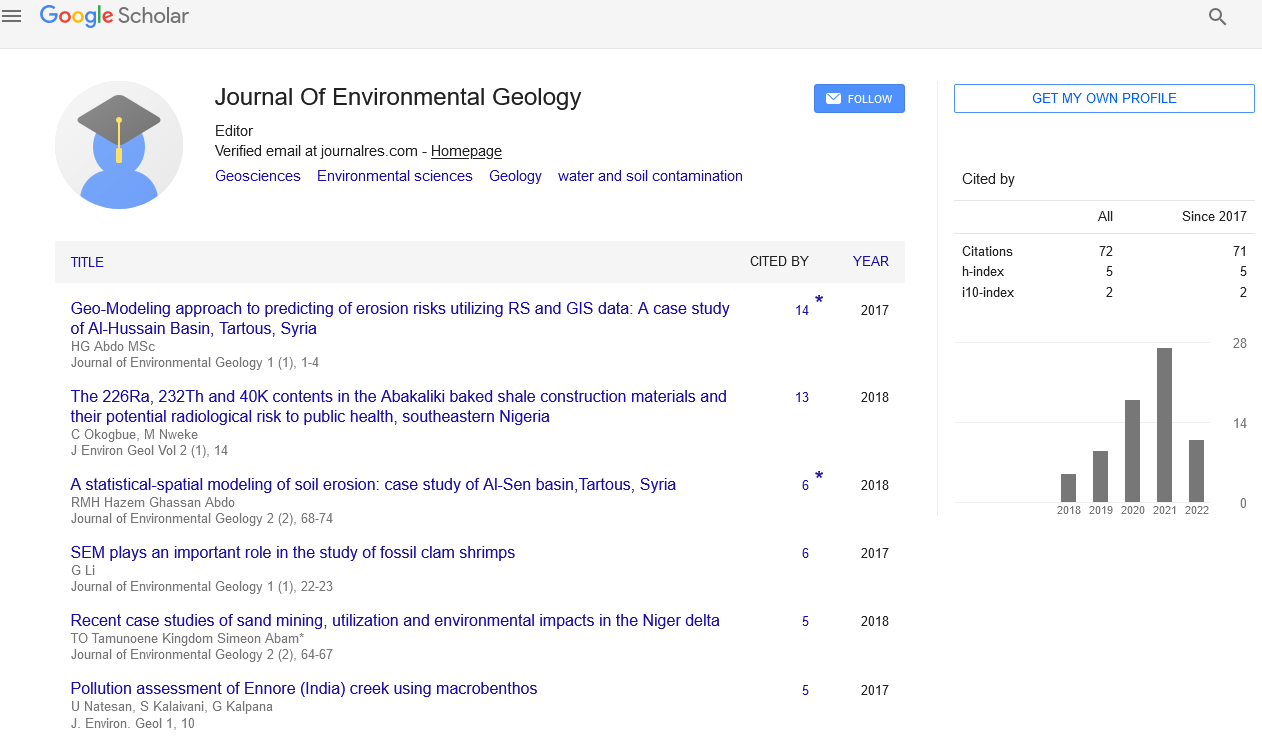Metal solubilization
Received: 21-Feb-2021 Accepted Date: Mar 06, 2021; Published: 13-Mar-2021
Citation: Jones S. Metal Solubilization. J Environ Geol. 2021;5(2):1.
This open-access article is distributed under the terms of the Creative Commons Attribution Non-Commercial License (CC BY-NC) (http://creativecommons.org/licenses/by-nc/4.0/), which permits reuse, distribution and reproduction of the article, provided that the original work is properly cited and the reuse is restricted to noncommercial purposes. For commercial reuse, contact reprints@pulsus.com
Editorial
Bioleaching is a direct and reliable method of separating metals from low-grade ores and mineral concentrates. The action of chemolithotrophic bacteria, primarily thiobacillus ferrooxidans and T. thiooxidans, converts insoluble metal sulphides into soluble metal sulphates, allowing metal recovery from sulphide minerals. Heterotrophic bacteria and fungi may handle non-sulfide ores and minerals. Metal extraction occurs in these situations as a result of the manufacture of organic acids as well as chelating and complexing compounds that are excreted into the air. Bioleaching is currently used mainly for the recovery of copper, plutonium, and gold, with heap, dump, and in situ leaching being the most common methods used. For the treatment of refractory gold ores, tank leaching is used. Metal recovery and detoxification from hazardous waste materials, sewage sludge, and heavy metal-contaminated soil are also possible through bioleaching.
The process of solubilization is known as bioleaching, and it occurs naturally wherever ideal conditions for the development of the ubiquitous bioleaching microorganisms exist. Thiobacillus, Leptospirillum, and thermophilic bacteria are among the microorganisms involved in bioleaching. Thiobacillus ferrooxidans and T. thiooxidans, acidophilic organisms, are particularly important.
Currently, bioleaching processes rely almost entirely on the operation of T. ferrooxidans, L. ferrooxidans, and T. thiooxidans, which convert heavily soluble metal sulphides into water-soluble metal sulphates through biochemical oxidation reactions. Metals can be released from sulphide minerals by both direct and indirect bacterial leaching in theory.
Bioleaching is Influenced by A Number of Factors
The efficacy of leaching is primarily determined by the microorganisms' productivity as well as the chemical and mineralogical composition of the ore to be leached. Only when the leaching conditions meet the bacteria's ideal growth conditions will optimum metal extraction yields are obtained.
pH
The correct pH value is needed for the growth of leaching bacteria and is crucial for metal solubilization. For bacterial oxidation of ferrous iron and sulphide, pH values in the range of 2.0-2.5 are ideal. T. ferrooxidans can be greatly inhibited at pH values below 2.0, however by raising acid addition; T. ferrooxidans will be modified to even lower pH values.
O2 and CO2
For good growth and operation of the leaching bacteria, an adequate supply of oxygen is needed. In the lab, this can be accomplished by aeration or stirring. On a technical level, adequate oxygen supply, especially in the case of dump or heap leaching, could pose some challenges. The only carbon source required is carbon dioxide, but no additional CO2 is required.
Nutrients
Since the microorganisms used to remove metals from sulphide products are chemolithoautotrophic bacteria, they can only thrive on inorganic compounds. Mineral nutrients are derived in general from the atmosphere and the material to be leached. Iron and sulphur compounds, as well as ammonium, phosphate and magnesium salts, can be used to fuel growth.
Temperature
T. ferrooxidans prefers a temperature of 28°C to 30°C for ferrous iron and sulphide oxidation. Metal extraction would be reduced at lower temperatures, but even at 4°C, bacterial solubilization of copper, cobalt, nickel, and zinc was observed. Thermophilic bacteria should be used for leaching at higher temperatures (50°C-80°C).
Heavy Metals
Metal sulphide leaching is associated with an increase in metal content in the leachate. Leaching species, especially thiobacilli, have a high tolerance for heavy metals in general, and some strains can tolerate up to 50 g/l Ni, 55 g/l Cu, or 112 g/l Zn. Different strains of certain species can react to heavy metals in completely different ways. Individual strains may also be suited to higher metal concentrations or particular substrates by increasingly increasing the concentration of metals or substrates.
Mineral substrate
The leaching substrate's mineralogical composition is extremely important. If the ore or gangue substance has a high carbonate content, the pH in the leaching liquid increases, inhibiting or completely suppressing bacterial activity. Low pH values, which are needed for the growth of the leaching bacteria, may be accomplished by adding acid externally, but this may result in the formation and precipitation of gypsum, as well as affecting the process' cost. The amount of leaching is also affected by the substrate's overall surface area. Since a reduction in particle size increases overall particle surface area, higher metal yields can be achieved without changing the total mass of the particles. A particle size of around 42 µm is thought to be ideal.
A rise in pulp density will also result in an increase in overall mineral surface area. Increased pulp density may result in increased metal extraction, but it will also result in increased dissolution of some compounds that have an inhibitory or even toxic effect on the growth of leaching bacteria.





